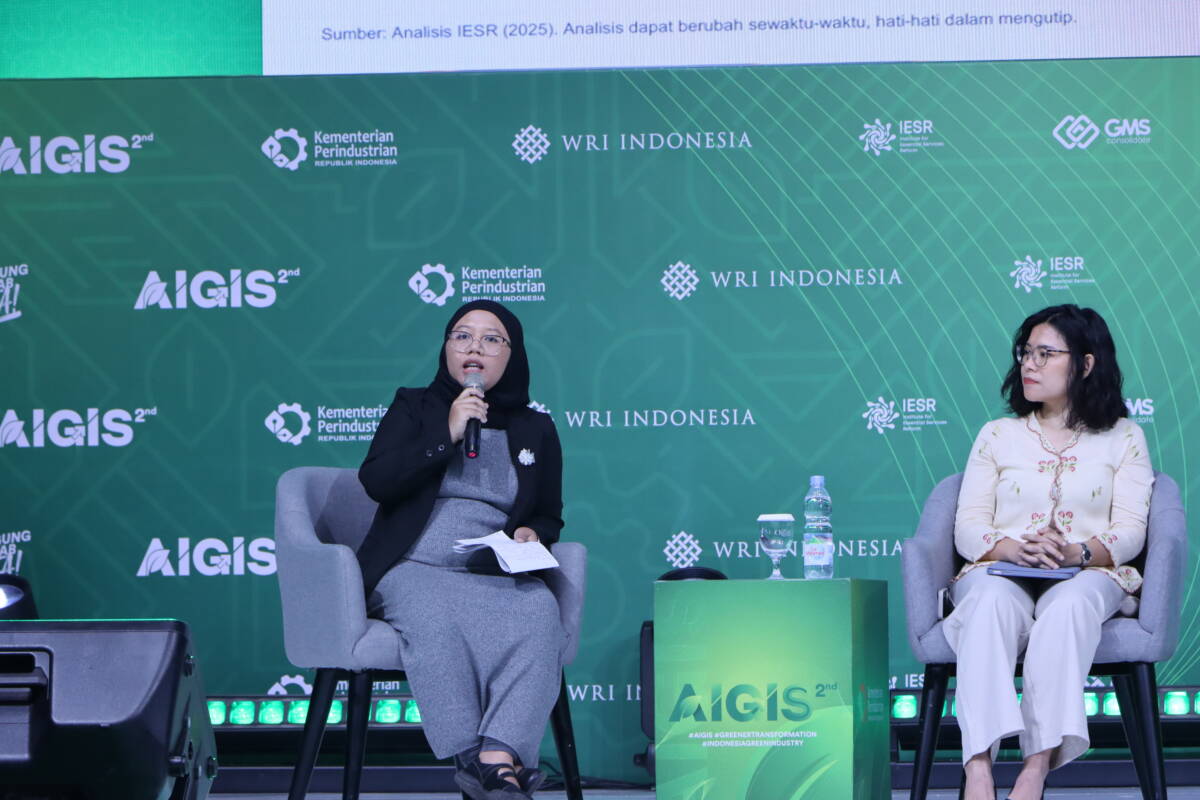Jakarta, August 21, 2025 – Industry is one of the backbones of the national economy. According to the latest Statistics Indonesia (BPS) data, the industrial sector contributes 18.9% to national GDP, employs 19.3 million workers, and attracts foreign investment worth IDR 80,538 trillion. Furthermore, 34% of national emissions come from industrial activities, with 36% of these emissions coming from high-energy industries such as cement, iron and steel, fertilizer, pulp and paper, textiles, glass and ceramics, food and beverages, and automotive. This was stated by Apit Pria Nugraha, Head of the Green Industry Center at the Indonesian Ministry of Industry, on the second day of 2nd AIGIS 2025 event on Thursday (21/8), which was also supported by the Institute for Essential Services Reform (IESR).
“These nine high-energy-intensive industrial sectors are prioritized for decarbonization. We have this decarbonization target to realize a competitive national industry operating with net-zero emissions by 2050 and to establish a green industrial ecosystem. Of course, numerous supporting instruments must be prepared, starting from the supply of energy, materials, and low-carbon technology, which must be affordable and reliable. There also needs to be a funding mechanism with diverse and easily accessible incentives, as well as a regulatory framework,” Apit emphasized.
To address this, Apit mentioned the government has prepared an Industrial Decarbonization Roadmap. However, this roadmap is still a living document, meaning it will be continuously updated as data and technology develop. Currently, the roadmap covers emissions from energy and industrial processes (IPPU), while the waste sector has not yet been mapped.
“This roadmap has two main outputs: a technical report containing emission reduction trajectories, decarbonization strategies, investment needs, impacts on product prices, and energy and material requirements; and a policy report containing an analysis of regulatory, funding, and technology gaps to support decarbonization,” said Apit.
Apit added that the official roadmap document will be launched in September 2025, followed by a policy report in March 2026, and supporting regulations in the form of a Ministerial Regulation of Industry in June 2026. Subsequently, regulations per subsector will be issued in stages starting in September 2026.
Apit emphasized that based on its emission profile, 46% of emissions in the manufacturing industry come from directly generated energy, 16% from purchased electricity, and 38% from chemical processes in the production and product application (IPPU). The manufacturing industry produces more energy emissions, although the proportion is fairly balanced with IPPU emissions.
The implementation of the Industrial Decarbonization Roadmap will contribute to a reduction of 68 million tons of carbon dioxide equivalent emissions by 2035 and 291 million tons of carbon dioxide equivalent emissions by 2050.
To reduce emissions while maintaining industrial competitiveness, the government has established five pillars of the decarbonization strategy. First, increasing energy and material efficiency to reduce resource consumption. Second, replacing fuels and materials with cleaner alternatives, including renewable energy. Third, transforming production processes to use low-carbon technologies. Fourth, encouraging electrification and the use of renewable energy in manufacturing processes. Fifth, developing carbon sequestration technologies such as CCU, CCS, and CCUS to support long-term emission reductions. All of these approaches emphasize the importance of reducing emissions first, before ultimately neutralizing the remaining emissions with carbon sequestration technologies.
Meanwhile, Faricha Hidayati, Coordinator of the Industrial Decarbonization Program at IESR, stated that the biggest challenges of this entire strategy are the availability of technology, investment costs, and sufficient clean energy supply. Green hydrogen, for example, is only expected to be widely adopted by 2030 because its price is still high at present. Similarly, carbon capture and utilization (CCU/S) technology requires adequate infrastructure planning and regulatory certainty as soon as possible, although its utilization is expected to remain in the long term due to the high cost of emissions reduction (abatement) compared to other technologies.
“Although the road ahead is long, Indonesia’s industrial decarbonization roadmap to 2050 offers hope. Key sectors such as textiles, automotive, glass, ceramics, cooking oil, and sugar can contribute significantly to reducing emissions if technological, electrification, and fuel-switching measures are implemented consistently. The key is collaboration between industry, government, and clean energy providers to ensure this transformation not only reduces emissions but also maintains the competitiveness of national industry in the global market,” said Faricha.

